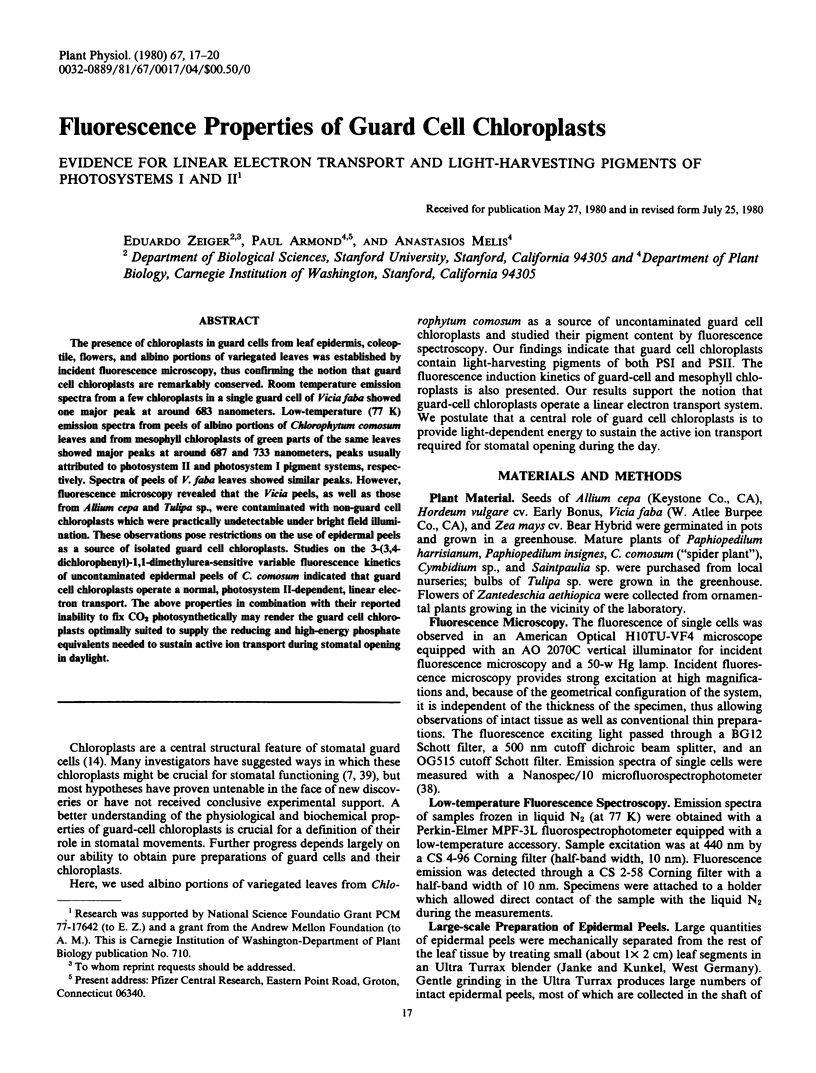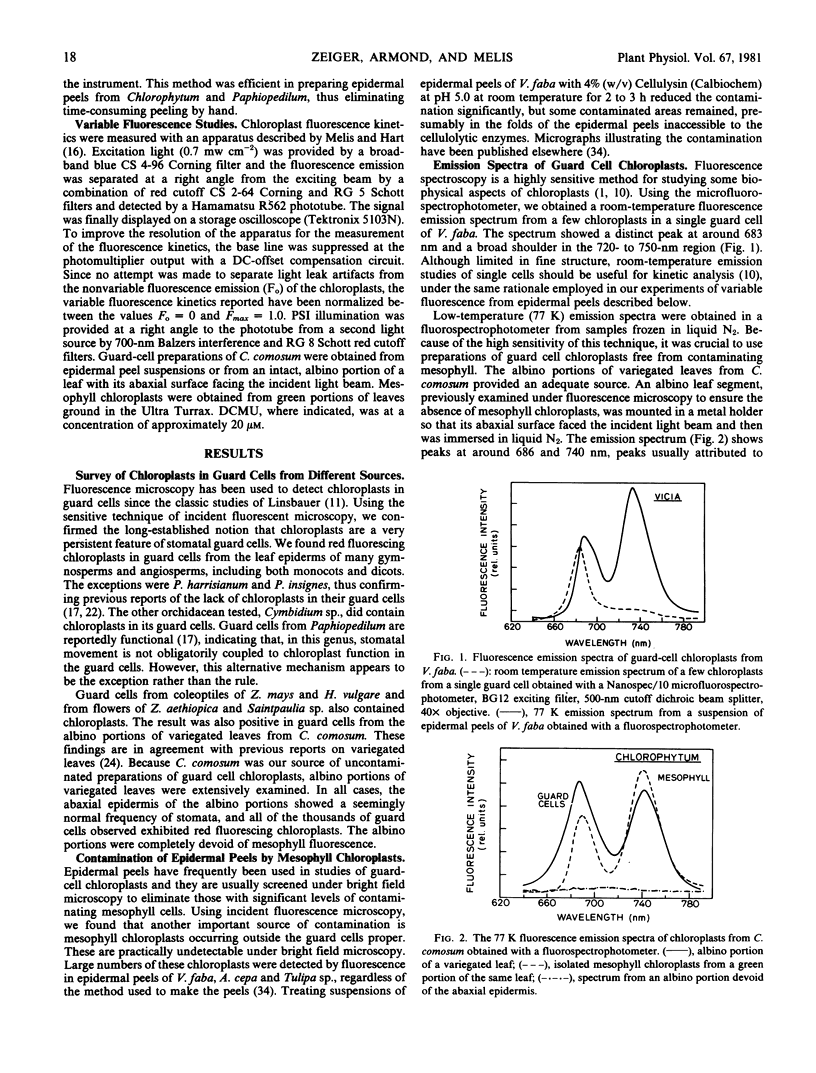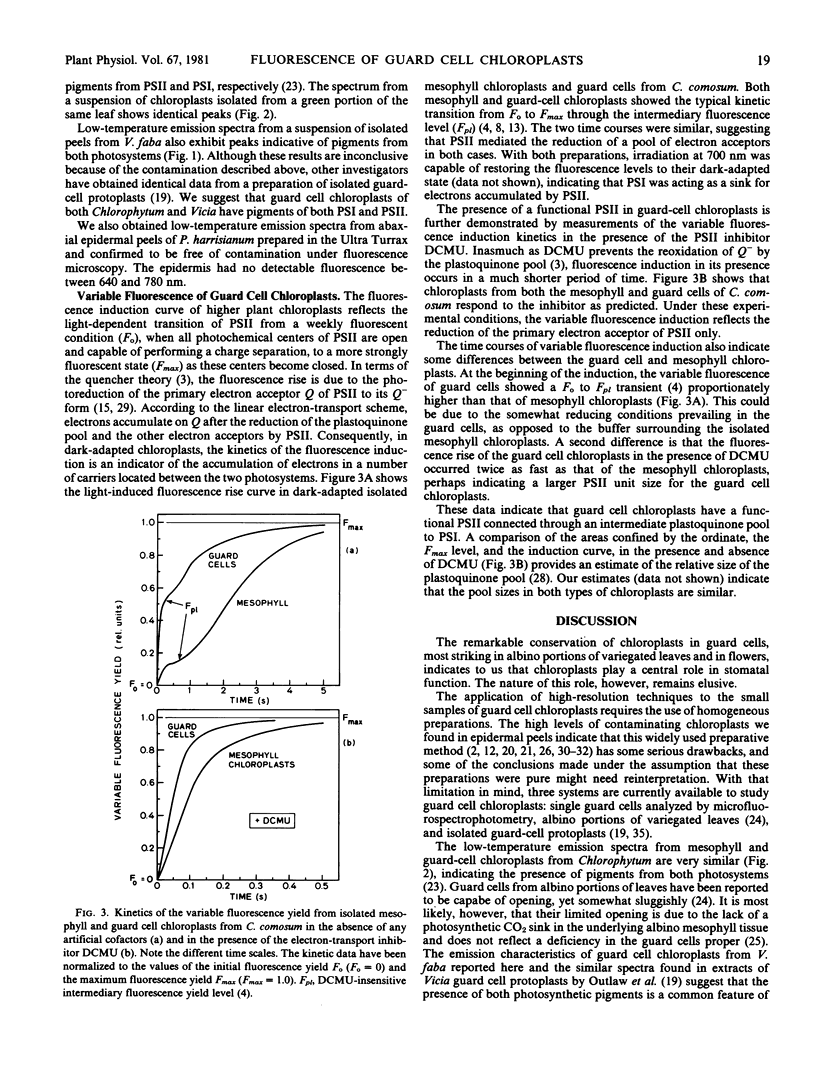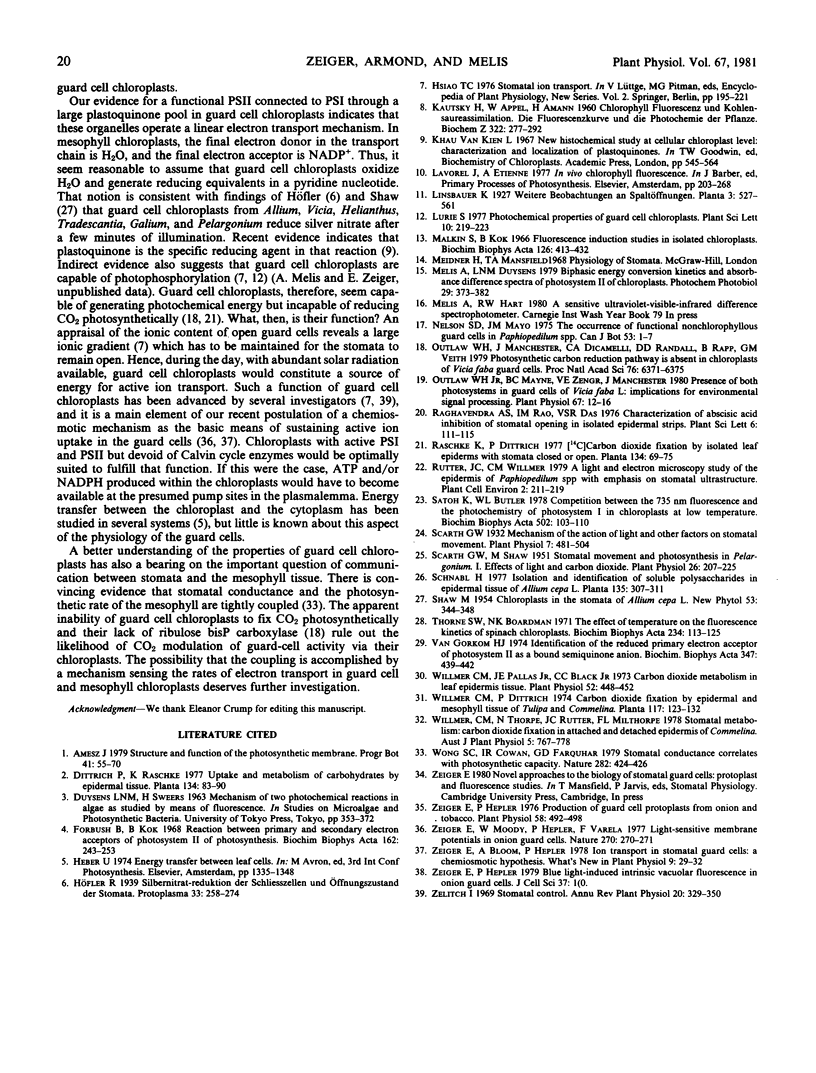Abstract
The presence of chloroplasts in guard cells from leaf epidermis, coleoptile, flowers, and albino portions of variegated leaves was established by incident fluorescence microscopy, thus confirming the notion that guard cell chloroplasts are remarkably conserved. Room temperature emission spectra from a few chloroplasts in a single guard cell of Vicia faba showed one major peak at around 683 nanometers. Low-temperature (77 K) emission spectra from peels of albino portions of Chlorophytum comosum leaves and from mesophyll chloroplasts of green parts of the same leaves showed major peaks at around 687 and 733 nanometers, peaks usually attributed to photosystem II and photosystem I pigment systems, respectively. Spectra of peels of V. faba leaves showed similar peaks. However, fluorescence microscopy revealed that the Vicia peels, as well as those from Allium cepa and Tulipa sp., were contaminated with non-guard cell chloroplasts which were practically undetectable under bright field illumination. These observations pose restrictions on the use of epidermal peels as a source of isolated guard cell chloroplasts. Studies on the 3-(3,4-dichlorophenyl)-1,1-dimethylurea-sensitive variable fluorescence kinetics of uncontaminated epidermal peels of C. comosum indicated that guard cell chloroplasts operate a normal, photosystem II-dependent, linear electron transport. The above properties in combination with their reported inability to fix CO2 photosynthetically may render the guard cell chloroplasts optimally suited to supply the reducing and high-energy phosphate equivalents needed to sustain active ion transport during stomatal opening in daylight.
Full text
PDF



Selected References
These references are in PubMed. This may not be the complete list of references from this article.
- Forbush B., Kok B. Reaction between primary and secondary electron acceptors of photosystem II of photosynthesis. Biochim Biophys Acta. 1968 Aug 20;162(2):243–253. doi: 10.1016/0005-2728(68)90106-0. [DOI] [PubMed] [Google Scholar]
- KAUTSKY H., APPEL W., AMANN H. [Chlorophyll fluorescence and carbon assimilation. Part XIII. The fluorescence and the photochemistry of plants]. Biochem Z. 1960;332:277–292. [PubMed] [Google Scholar]
- Malkin S., Kok B. Fluorescence induction studies in isolated chloroplasts. I. Number of components involved in the reaction and quantum yields. Biochim Biophys Acta. 1966 Nov 8;126(3):413–432. doi: 10.1016/0926-6585(66)90001-x. [DOI] [PubMed] [Google Scholar]
- Outlaw W. H., Manchester J., Dicamelli C. A., Randall D. D., Rapp B., Veith G. M. Photosynthetic carbon reduction pathway is absent in chloroplasts of Vicia faba guard cells. Proc Natl Acad Sci U S A. 1979 Dec;76(12):6371–6375. doi: 10.1073/pnas.76.12.6371. [DOI] [PMC free article] [PubMed] [Google Scholar]
- Outlaw W. H., Mayne B. C., Zenger V. E., Manchester J. Presence of Both Photosystems in Guard Cells of Vicia faba L: IMPLICATIONS FOR ENVIRONMENTAL SIGNAL PROCESSING. Plant Physiol. 1981 Jan;67(1):12–16. doi: 10.1104/pp.67.1.12. [DOI] [PMC free article] [PubMed] [Google Scholar]
- Satoh K., Butler W. L. Competition between the 735 nm fluorescence and the photochemistry of Photosystem I in chloroplasts at low temperature. Biochim Biophys Acta. 1978 Apr 11;502(1):103–110. doi: 10.1016/0005-2728(78)90135-4. [DOI] [PubMed] [Google Scholar]
- Scarth G. W. MECHANISM OF THE ACTION OF LIGHT AND OTHER FACTORS ON STOMATAL MOVEMENT. Plant Physiol. 1932 Jul;7(3):481–504. doi: 10.1104/pp.7.3.481. [DOI] [PMC free article] [PubMed] [Google Scholar]
- Scarth G. W., Shaw M. STOMATAL MOVEMENT AND PHOTOSYNTHESIS IN PELARGONIUM. I. EFFECTS OF LIGHT AND CARBON DIOXIDE. Plant Physiol. 1951 Apr;26(2):207–225. doi: 10.1104/pp.26.2.207. [DOI] [PMC free article] [PubMed] [Google Scholar]
- Thorne S. W., Boardman N. K. The effect of temperature on the fluorescence kinetics of spinach chloroplasts. Biochim Biophys Acta. 1971 Apr 6;234(1):113–125. doi: 10.1016/0005-2728(71)90136-8. [DOI] [PubMed] [Google Scholar]
- Willmer C. M., Pallas J. E., Black C. C. Carbon dioxide metabolism in leaf epidermal tissue. Plant Physiol. 1973 Nov;52(5):448–452. doi: 10.1104/pp.52.5.448. [DOI] [PMC free article] [PubMed] [Google Scholar]
- Zeiger E., Hepler P. K. Production of guard cell protoplasts from onion and tobacco. Plant Physiol. 1976 Oct;58(4):492–498. doi: 10.1104/pp.58.4.492. [DOI] [PMC free article] [PubMed] [Google Scholar]
- van Gorkom H. J. Identification of the reduced primary electron acceptor of photosystem II as a bound semiquinone anion. Biochim Biophys Acta. 1974 Jun 28;347(3):439–442. doi: 10.1016/0005-2728(74)90081-4. [DOI] [PubMed] [Google Scholar]


